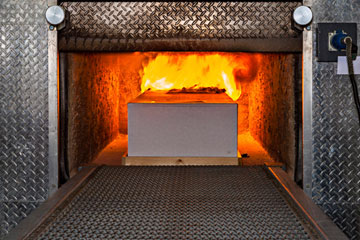
A body in the fire-based crematory oven of Lakewood Cemetery.
(3 of 8)
By the turn of the century, cremationists began building elaborate crematories with stained-glass windows, marble floors and frescoed walls. "The cemeterians across the country started this idea that when someone died, there must be a memorial, otherwise what's the point of what we do?" says Engler. "And cremationists, many of which were cemeterians also, adopted that idea as well. That was really where cremation started to gain some sort of popularity." Light-filled columbaria, or vaults designed for urns, were built to permanently hold ashes, and CANA was formed to further the idea of creating memorials for those who pass--and to help cremationists get the most out of their bottom line through sales of urns and niche columbarium spaces.
Still, by the 1960s, the cremation rate was stuck at 3%. Jessica Mitford's muckraking classic The American Way of Death, which exposed the funeral-home industry for willfully taking advantage of fragile families and pushing ridiculous funeral-related merchandise, helped cremationists by showing Americans that there were alternatives to burial. But the practice only became widespread decades later, when the cremation rate hit double digits. And the rationale this time was the pocketbook.
In 2008, before the recession hit, the national cremation rate was 36.2% and had been growing about 1 percentage point a year, according to CANA. But that growth rate doubled in the years that followed--and some states in particular witnessed dramatic increases. Wyoming's cremation rate went from 42.3% in 2006 to 56.1% in 2010, Tennessee's increased from 16% to 27.6%, and Rhode Island's jumped from 27.5% to 37.5%. In 2011, every state in the union performed more cremations than it had the year before.
CANA, the largest organization representing crematories and funeral homes in the U.S. and Canada, says the price for an average cremation is $2,570. A traditional burial averages $7,755 when a vault, often required by cemeteries, is included, according to the National Funeral Directors Association. CANA and NFDA are virtually the only organizations that track these costs, and both want to make their industry look as attractive as possible from a cost standpoint. But price alone can't fully explain the recent rush to embrace cremation. Before you make up your mind, however, you may want to know what, exactly, your cremation will entail.
Into the Fire
Let's say you die--sorry, but it happens to the best of us--and your family has decided to cremate you. (Hopefully, you approve.) First, you'll likely be placed in a plain coffin or cardboard container. You may have a tag put somewhere on your body or a metal disc placed inside your vessel with a unique number along with matching paperwork so the crematory operators know you're you. But for now, you're no longer you. You're No. 15678.
